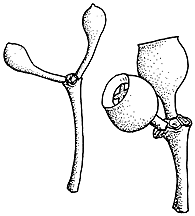Common name: Alpine Ash
Eucalyptus delegatensis R.T.Baker APNI* Synonyms: Eucalyptus obliqua var. alpina Maiden APNI*

Description: Tree to 50 m high, rarely to 90 m; bark persistent on lower trunk, grey, grey-brown or red-brown, shortly fibrous to stringy (deeply furrowed), smooth above, grey or grey-brown, shedding in long ribbons.
Juvenile leaves disjunct, broad-lanceolate to ovate, dull grey-green. Adult leaves disjunct, lanceolate, 10–20 cm long, 1.5–4 cm wide, green, glossy, concolorous.
Umbellasters 7–11–15-flowered; peduncle terete or angular, 9–20 mm long; pedicels terete, 2–7 mm long. Buds clavate, sometimes glaucous, 5–6 mm long, 3–4 mm diam., scar absent; calyptra hemispherical or shortly conical, sometimes beaked, shorter than and as wide as hypanthium.
Fruit hemispherical or pyriform or ovoid, 3–5-locular, 8–15 mm long, 6–11 mm diam.; disc depressed or rarely flat; valves enclosed.
Distribution and occurrence: Widespread and often dominant, in grassy or wet sclerophyll subalpine forest on deep fertile often sloping soil; south from Brindabella Ra., A.C.T.
NSW subdivisions: ST
Other Australian states: Vic.
Text by K. Hill
Taxon concept:
APNI* Provides a link to the Australian Plant Name Index (hosted by the Australian National Botanic Gardens) for comprehensive bibliographic data
***The AVH map option provides a detailed interactive Australia wide distribution map drawn from collections held by all major Australian herbaria participating in the Australian Virtual Herbarium project.
|


